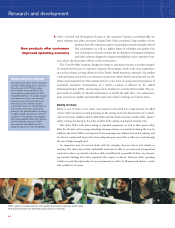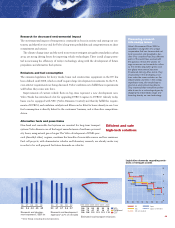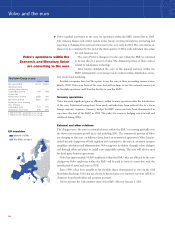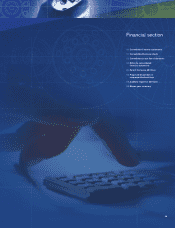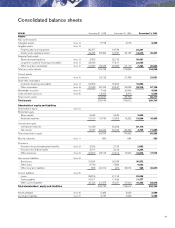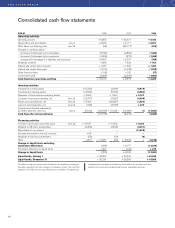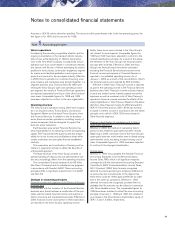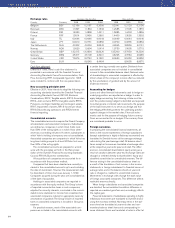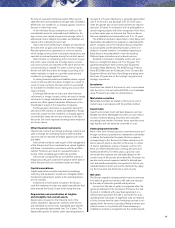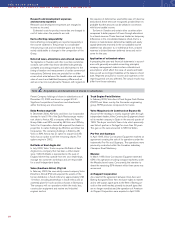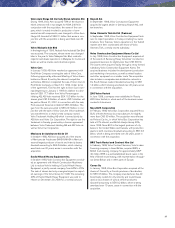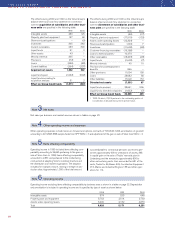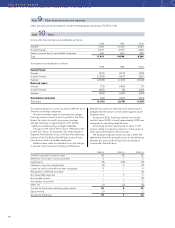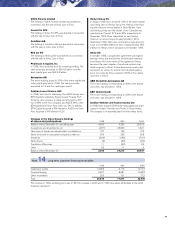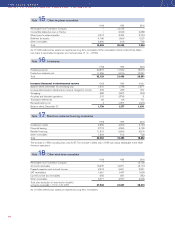Volvo 2000 Annual Report Download - page 56
Download and view the complete annual report
Please find page 56 of the 2000 Volvo annual report below. You can navigate through the pages in the report by either clicking on the pages listed below, or by using the keyword search tool below to find specific information within the annual report.
THE VOLVO GROUP
NOTES TO CONSOLIDATED FINANCIAL STATEMENTS
54
Cash flow statement
Effective in 1999, Volvo’s cash flow statement is
presented in accordance with the Swedish Financial
Accounting Standards Council’s recommendation, Cash
Flow Accounting, RR7. Comparable figures for 1998
were restated to conform with the new presentation.
New accounting principles 2001
Effective in 2001, Volvo intends to adopt the following new
accounting standards issued by the Swedish Financial
Accounting Standards Council, RR1:00, Business
Combinations, RR12, Tangible assets, RR13, Associates,
RR14, Joint ventures, RR15, Intangible assets, RR16,
Provisions, contingent liabilities and contingent assets,
RR17, Impairment of assets, RR18 Income per share,
RR19, Discontinuing operations and RR20, Interim
financial reporting.
Consolidated accounts
The consolidated accounts comprise the Parent Company,
all subsidiaries and associated companies. Subsidiaries
are defined as companies in which Volvo holds more
than 50% of the voting rights or in which Volvo other-
wise has a controlling influence. However, subsidiaries in
which Volvo’s holding is temporary are not consolidated.
Associated companies are companies in which Volvo has
long-term holdings equal to at least 20% but not more
than 50% of the voting rights.
The consolidated accounts are prepared in accord-
ance with the principles set forth in the Recommen-
dation of the Swedish Financial Accounting Standards
Council, RR1:96, Business combinations.
All acquisitions of companies are accounted for in
accordance with the purchase method.
Companies that have been divested are normally in-
cluded in the consolidated accounts up to and including
the date of divestment. However the measurement date
for divestment of Volvo Cars was January 1, 1999.
Companies acquired during the year are consolidated as
of the date of acquisition.
Holdings in associated companies are reported in
accordance with the equity method. The Group’s share
of reported income before taxes in such companies,
adjusted for minority interests, is included in the consoli-
dated income statement in Income from investments in
associated companies, reduced in appropriate cases by
amortization of goodwill. The Group’s share of reported
taxes in associated companies, is included in Group tax
expense.
For practical reasons, most of the associated com-
panies are included in the consolidated accounts with
a certain time lag, normally one quarter. Dividends from
associated companies are not included in consolidated
income. In the consolidated balance sheet, the book value
of shareholdings in associated companies is affected by
Volvo’s share of the company’s income after tax, reduced
by the amortization of goodwill and by the amount of
dividends received.
Accounting for hedges
Loans and other financial instruments used to hedge an
underlying position are reported as a hedge. In order to
apply hedge accounting, the following criteria must be
met: the position being hedged is identified and exposed
to exchange-rate or interest-rate movements, the purpose
of the loan/instrument is to serve as a hedge and that
the hedging effectively protects the underlying position
against changes in the market rates. Financial instru-
ments used for the purpose of hedging future currency
flows are accounted for as hedges if the currency flows
are considered probable to occur.
Foreign currencies
In preparing the consolidated financial statements, all
items in the income statements of foreign subsidiaries
(except subsidiaries in highly inflationary economies) are
translated to Swedish kronor at the average exchange
rates during the year (average rate). All balance sheet
items except net income are translated at exchange rates
at the respective year-ends (year-end rate). The differ-
ences in consolidated shareholders’ equity arising as a
result of variations between year-end exchange rates are
charged or credited directly to shareholders’ equity and
classified as restricted or unrestricted reserves. The dif-
ference arising in the consolidated balance sheet as
a result of the translation of net income, in the income
statements, in foreign subsidiaries’ to Swedish kronor at
average rates, and in the balance sheets at year-end
rate, is charged or credited to unrestricted reserves.
Movements in exchange rates change the book value
of foreign associated companies. This difference affects
restricted reserves directly.
When foreign subsidiaries and associated companies
are divested, the accumulated translation difference is
reported as a realized gain/loss and, accordingly, affects
the capital gain.
Financial statements of subsidiaries operating in highly
inflationary economies are translated to Swedish kronor
using the monetary method. Monetary items in the bal-
ance sheet are translated at year-end rates and non-
monetary balance sheet items and corresponding in-
come statement items are translated at rates in effect at
Exchange rates Average rate Jan–Dec Year-end rate
Country Currency 1998 1999 2000 1998 1999 2000
Belgium BEF 0.2196 0.2187 0.2095 0.2341 0.2123 0.2196
Denmark DKK 1.1897 1.1864 1.1334 1.2685 1.1505 1.1870
Finland FIM 1.4930 1.4838 1.4211 1.5885 1.4403 1.4896
France FRF 1.3514 1.3450 1.2881 1.4400 1.3055 1.3502
Italy ITL 0.0046 0.0046 0.0044 0.0049 0.0044 0.0046
Japan JPY 0.0610 0.0731 0.0850 0.0700 0.0835 0.0832
The Netherlands NLG 4.0202 4.0034 3.8342 4.2865 3.8859 4.0191
Norway NOK 1.0520 1.0604 1.0414 1.0730 1.0605 1.0715
Great Britain GBP 13.2215 13.3834 13.8620 13.5200 13.7950 14.2200
Germany DEM 4.5317 4.5108 4.3201 4.8295 4.3784 4.5285
United States USD 7.9676 8.2742 9.1581 8.0650 8.5250 9.5350
Euro EUR – 8.8245 8.4494 – 8.5635 8.8570


